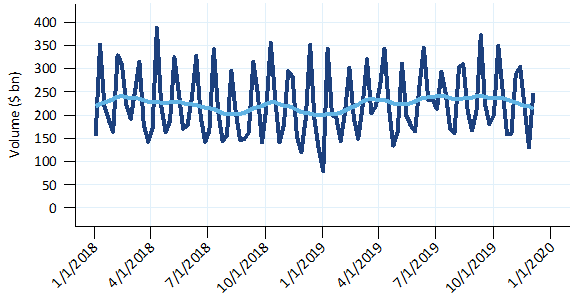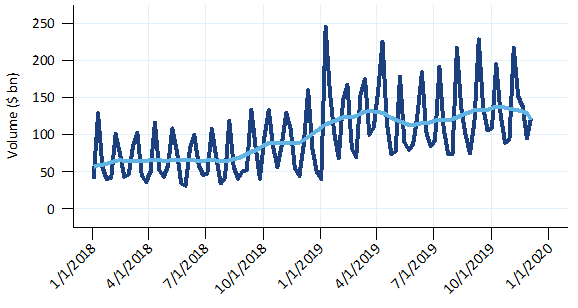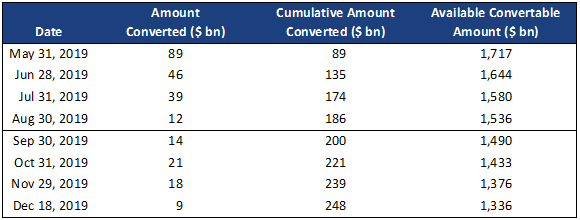Uncategorized
TBA trading volumes remain strong
admin | December 20, 2019
This document is intended for institutional investors and is not subject to all of the independence and disclosure standards applicable to debt research reports prepared for retail investors.
The mid-2019 launch of the new Uniform Mortgage-Backed Security may go down as one of the smoothest sweeping changes ever made to the agency MBS market. Both Fannie Mae and Freddie Mac pools became eligible for delivery into the same UMBS TBA contract. Almost seven months into the UMBS-era, TBA and dollar roll trading volumes remain healthy and the process for exchanging Gold pools for UMBS pools seems trouble-free.
TBA volumes were high throughout the second half of the year
TBA trading volume remained strong throughout the second half of 2019, peaking in October. Trading activity after the introduction of UMBS appears to have generally surpassed levels prior to UMBS (Exhibit 1).
Exhibit 1: TBA Trading Volume

Note: The dark blue line is weekly trading volume, the light blue is fit using LOESS to smooth seasonal variation. Source: Federal Reserve Bank of New York, Amherst Pierpont Securities
Activity peaked in July and October, both months coinciding with a pickup in prepayments and pool production following successive refinance waves. Activity has slowed a bit going into year-end, which could be due to seasonal slowdowns or possibly slowing prepayments. It seems pretty clear that UMBS did not slow, and probably has slightly increased, TBA trading volumes.
Dollar roll trading also remained high in the second half of the year
Dollar roll volumes were also high throughout the second half of 2019. After slowing during the two months preceding UMBS, dollar roll activity trended steadily higher and peaked in October (Exhibit 2). Similar to TBA, trading activity has fallen a bit into year-end.
Exhibit 2: Dollar Roll Volume

Note: The dark blue line is weekly trading volume, the light blue line is fit using LOESS to smooth seasonal variation. Source: Federal Reserve Bank of New York, Amherst Pierpont Securities
As with TBA trading, it appears that the UMBS contract has not hurt, and likely helped, increase dollar roll trading volume.
Freddie Mac exchanges slow down
The process for exchanging Freddie Mac pools into UMBS began in May and by all accounts has operated very smoothly. The initial volume of exchanges was very high, with nearly $90 billion converted by the end of May (Exhibit 3).
Exhibit 3: Freddie Mac Gold to UMBS Exchange Activity

Source: Freddie Mac, Amherst Pierpont Securities
However exchange activity has dropped substantially since the first three months, totaling less than $20 billion in November. Only $9 billion has been exchanged through December 18, which extrapolates to roughly $15 billion for December. There are about $1.3 trillion of Gold pools outstanding and still available to exchange, although roughly $215 billion of that is locked up in CMOs. So investors seem to feel little pressure to exchange pools, and when investors do want to exchange a pool, Freddie Mac should have plenty of capacity to do the transaction.
This material is intended only for institutional investors and does not carry all of the independence and disclosure standards of retail debt research reports. In the preparation of this material, the author may have consulted or otherwise discussed the matters referenced herein with one or more of SCM’s trading desks, any of which may have accumulated or otherwise taken a position, long or short, in any of the financial instruments discussed in or related to this material. Further, SCM may act as a market maker or principal dealer and may have proprietary interests that differ or conflict with the recipient hereof, in connection with any financial instrument discussed in or related to this material.
This message, including any attachments or links contained herein, is subject to important disclaimers, conditions, and disclosures regarding Electronic Communications, which you can find at https://portfolio-strategy.apsec.com/sancap-disclaimers-and-disclosures.
Important Disclaimers
Copyright © 2024 Santander US Capital Markets LLC and its affiliates (“SCM”). All rights reserved. SCM is a member of FINRA and SIPC. This material is intended for limited distribution to institutions only and is not publicly available. Any unauthorized use or disclosure is prohibited.
In making this material available, SCM (i) is not providing any advice to the recipient, including, without limitation, any advice as to investment, legal, accounting, tax and financial matters, (ii) is not acting as an advisor or fiduciary in respect of the recipient, (iii) is not making any predictions or projections and (iv) intends that any recipient to which SCM has provided this material is an “institutional investor” (as defined under applicable law and regulation, including FINRA Rule 4512 and that this material will not be disseminated, in whole or part, to any third party by the recipient.
The author of this material is an economist, desk strategist or trader. In the preparation of this material, the author may have consulted or otherwise discussed the matters referenced herein with one or more of SCM’s trading desks, any of which may have accumulated or otherwise taken a position, long or short, in any of the financial instruments discussed in or related to this material. Further, SCM or any of its affiliates may act as a market maker or principal dealer and may have proprietary interests that differ or conflict with the recipient hereof, in connection with any financial instrument discussed in or related to this material.
This material (i) has been prepared for information purposes only and does not constitute a solicitation or an offer to buy or sell any securities, related investments or other financial instruments, (ii) is neither research, a “research report” as commonly understood under the securities laws and regulations promulgated thereunder nor the product of a research department, (iii) or parts thereof may have been obtained from various sources, the reliability of which has not been verified and cannot be guaranteed by SCM, (iv) should not be reproduced or disclosed to any other person, without SCM’s prior consent and (v) is not intended for distribution in any jurisdiction in which its distribution would be prohibited.
In connection with this material, SCM (i) makes no representation or warranties as to the appropriateness or reliance for use in any transaction or as to the permissibility or legality of any financial instrument in any jurisdiction, (ii) believes the information in this material to be reliable, has not independently verified such information and makes no representation, express or implied, with regard to the accuracy or completeness of such information, (iii) accepts no responsibility or liability as to any reliance placed, or investment decision made, on the basis of such information by the recipient and (iv) does not undertake, and disclaims any duty to undertake, to update or to revise the information contained in this material.
Unless otherwise stated, the views, opinions, forecasts, valuations, or estimates contained in this material are those solely of the author, as of the date of publication of this material, and are subject to change without notice. The recipient of this material should make an independent evaluation of this information and make such other investigations as the recipient considers necessary (including obtaining independent financial advice), before transacting in any financial market or instrument discussed in or related to this material.





